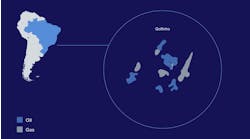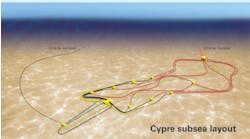L.Waintraub
Proser
Efficient crude oil separation is a key element of any production facility, but the design is especially important for floating production units where the imposed motions to the liquid phases conflict with the separation process.
The purpose of crude oil separation is to achieve maximum recovery in two to four stages of pressure reduction, followed by electrostatic coalescence. Associated gas is usually reinjected, with produced water either reinjected or disposed of. Normal performance requirements are:
- oil: BSW (basic, sediment, water) of 0.1-0.5% and/or a salt content of 10PTB (pounds per thousands of barrels)
- water:oil content at separator outlet of 1,000-2,000ppm and 40ppm after cleaning.
- Operation of a 3-phase gas/oil/water separator depends on:
- an inlet diverter to absorb the energy of the incoming mixed phases: this diverter or inlet momentum breaker should distribute the flow equally and avoid foam or emulsion formation
- a gas section where liquid droplets are separated by gravity (stocks law) and by various coalescing media (mesh, vane pack)
- a liquid section where liquids are de-gassed and oil and water phase-separated by gravity. Droplet distribution and coalescing are the key factor of the design.
- Such a separator will typically feature:
- a horizontal vessel with an L/D ratio of 3 to 5
- a gas section between 1/4 and 1/5 the total area.
- a liquid section fully 50-60% of the vessel during normal operation.
- a dead space between the liquid level and the gas section of 15-25% of the total section, depending on the foaming tendency of the crude oil.
Marine motion impact
The six different marine motions - pitch, roll, sway, surge, heave, and yaw - have varying impacts on different types of floating production units.
- Mono-hull/semi-submersible: roll and pitch as a regular, rotating motion are the leading parameter for the process and instrumentation design, due to induced frequencies and the risk of resonance for both gas/oil and oil/water interfaces. Sway, surge and heave are significant to mechanical design, less so on process design.
The effect of sloshing with acceleration as high as 0.5/0.7g with full liquid load is the leading design parameter for the saddle and supporting structure. Yaw is not a determining factor.
- Tension leg platform: the TLP concept reduces the degree of freedom. Sway surge and secondary yaw must be taken into account for both periodic solicitation and mechanical design.
As can be seen, the basic problem to be overcome is proper handling of gas/liquid and liquid/liquid separation according to the floater's imposed motions. The theoretical approach is to evaluate the frequency, period and amplitude of the free surface and liquid/liquid interface as a response to the induced motion, and then to define the risk of resonance and accommodate the proper dampening devices.
The theoretical basis for evaluating liquids in vessels subject to motion has been developed both in the aerospace industry, for sloshing in fuel tanks, and in LNG carriers, where sloshing can severely damage the thin wall reservoir.
The basis of the theory is application of the Navier-Stocks law. The difficulty in the application lies in the geometry of the separator, the modelisation of the dampening devices, behavior of the liquid/liquid interface and many other factors related to a natural product where viscosity, emulsion and foaming is hard to predict and put into an equation. This means that calculations and simulations must be verified as much as possible, and at least compared with model tests.
Floater design criteria
The main objective is to design efficient dampening systems. This has led, through trial and error, to a number of directive criteria for designers:
- vessel length in the direction of less motion
- resonance to be avoided by dividing the vessel length into sections where natural frequencies are away from the induced value
- transversal baffles, perforated or partial, are good for single liquid phase, but poor for a liquid/liquid interface, causing remixing
- longitudinal baffle to be avoided
- structured packing has proved to be efficient
- uniform distribution of liquids is a must for an efficient liquid/liquid separator
- as the response period of the oil/water interface relates to the position of the interface level, repositioning of internals should be available to cope with the natural variation of effluent composition during the production life
- level instrumentation should be located as close as possible to the center of rotation to avoid complicated timing systems or multiplication of sensors
- support saddles and structure design must take into account longitudinal and transverse acceleration.
For over a decade, Proser has been involved in designing separators for floating production.
Copyright 1996 Offshore. All Rights Reserved.


